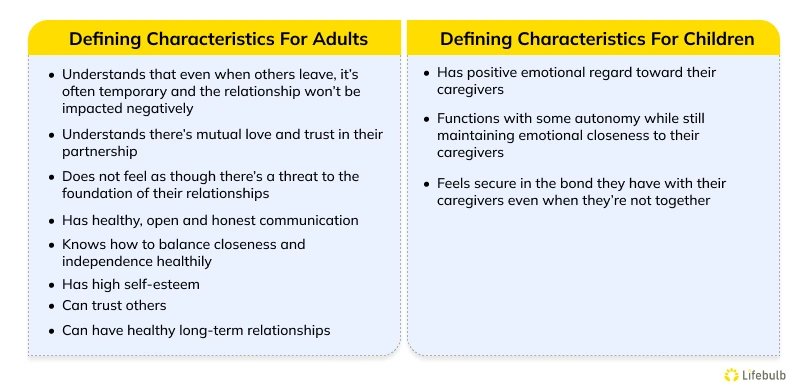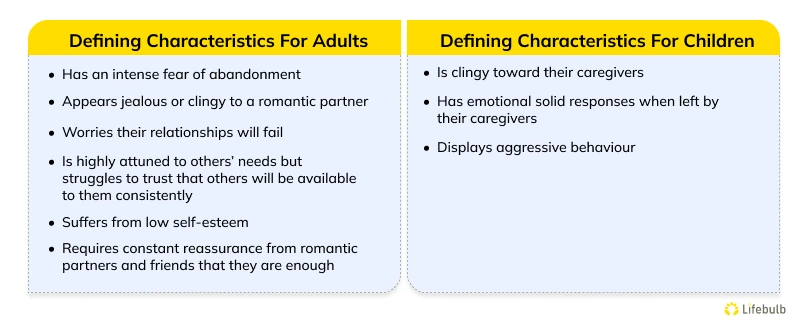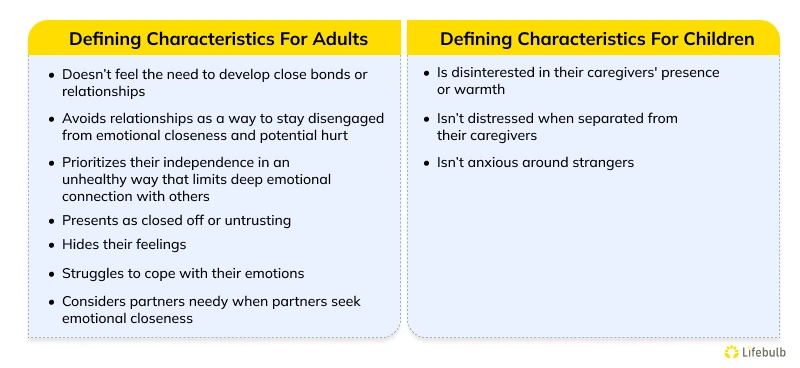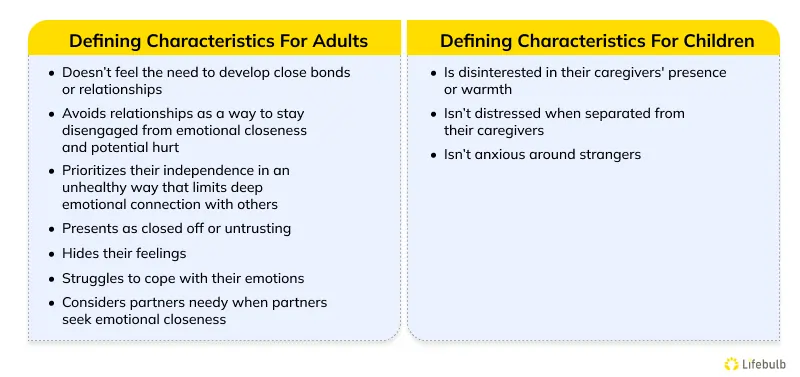Our attachment styles shape our relationships and how we connect with others. Understanding this level of interest is entirely understandable, as the different attachment styles in relationships can impact interpersonal interactions in unique ways. The different types of attachment styles include the way we tend to react emotionally to others, how we usually interact with members in relationships, and how we behave when it comes to relationships in general.
Keep reading and learn more about the primary attachment styles, how they affect our relationships, and how you can determine yours. You can always seek help from trained mental health professionals if you’re struggling with relationships.
History of attachment styles: Ainsworth “Strange Situation” Study
Mary Ainsworth's "Strange Situation" study, conducted in the 1970s, aimed to observe attachment security in children within the context of their caregiver relationships. The protocol involved a series of eight short episodes meant to assess how infants of nine to 18 months old responded to the presence of their caregiver, their separation, and eventual reunion with them. There were three stages of the study:
- The child would be in a room with their caregiver. They would engage and play.
- The caregiver left the room and the infant was either left alone or with a stranger
- The infant was reunited with their caregiver after the separation periods.
Through careful observation of the infants' behaviors and reactions during these sequences, and specifically how the infant responded to their caregivers when they came back into the room, Ainsworth identified and classified three main attachment styles: secure, anxious-ambivalent, and avoidant.
In 1986, a fourth attachment style was added: disorganized attachment.
The results of Ainsworth's "Strange Situation" study had a profound influence on psychology, particularly in the field of attachment theory. It provided empirical evidence for the concepts outlined in John Bowlby's attachment theory and deepened the understanding of how early attachment experiences shape an individual's social and emotional development throughout life.
How do attachment styles shape relationships?
Attachment styles are not the only thing influencing relationships—they don’t account for conscious thought and mindful behavior, after all. Also, as we discussed above, they can change! If you’re shifting from one attachment style to another, how you relate to people may look different than what’s been discussed here.
However, it’s undeniable that attachment styles have some say in how we form relationships. Let’s look at a few ways below.
- Shaping Communication and Emotional Intimacy:
Our attachment styles paint a vivid backdrop for how we communicate, express emotions, and navigate intimacy in relationships. Individuals with secure attachment styles often find it easier to engage in open, honest communication, fostering a deeper sense of emotional closeness. Conversely, those with insecure attachment styles may grapple with expressing emotions, setting boundaries, or finding a healthy balance between autonomy and interdependence. - Influencing Conflict Resolution and Trust:
Attachment styles play a pivotal role in shaping how we approach conflict and trust within relationships. Securely attached individuals often demonstrate a greater capacity to navigate disagreements with empathy and understanding, fostering a sense of trust and emotional safety. In contrast, individuals with insecure attachment styles may struggle with conflict resolution, tending toward emotional volatility or withdrawal, ultimately impacting the establishment of trust within the relationship. - Impacting Patterns of Relational Dynamics:
The interplay of attachment styles can influence the overarching patterns of relational dynamics within romantic, familial, or friendship connections. Individuals with secure attachment styles often gravitate toward balanced, nurturing relationships, fostering mutual support and understanding. Meanwhile, those with insecure attachment styles may find themselves entangled in patterns of anxious preoccupation, avoidance of intimacy, or ambivalence in their relational behaviors. - Fostering Healing and Transformation:
Understanding the impact of attachment styles can serve as a foundational compass for fostering healing and transformation within relationships. By delving into the roots of attachment patterns, individuals can gain a greater understanding of their relational tendencies and work towards reshaping these dynamics. With the support of a compassionate therapist and a willingness to explore past experiences, individuals can embark on a journey of forging healthier, more secure attachment patterns.
By shining a light on the influence of attachment styles within relationships, we empower ourselves to cultivate deeper self-awareness and empathy for others. Through this understanding, we embark on a path toward nurturing more secure, fulfilling connections with the potential to transform our emotional landscapes. Remember, the journey toward healthier relationships begins with a compassionate commitment to self-growth and the nurturing of secure, balanced connections that honor our brightest lives.
What are the 4 types of attachment styles?
It can be hard to pinpoint your exact attachment style. We all want to have a healthy, secure attachment. If you resonate more with anxious, detached, or disorganized attachment, remember: You didn’t choose your attachment style. It is a reflection of your relationship with your parents when you were an infant and young child, and therefore not in your control. Also, it is possible to heal from past wounds and traumas, building healthier behavior and effectively changing your attachment style.
So, let's explore the four attachment styles.
Secure Attachment Style
This is the healthiest attachment style. Feelings of safety, trust, and deep connection come from having a secure attachment style. Secure attachment is like having a sturdy emotional foundation that gives you the confidence to explore the world and form meaningful relationships. It's built on trust, empathy, and a deep sense of security, providing a nurturing base for emotional growth and connection with others.
Characteristics of Secure Attachment
- Comfortable with Intimacy: People with secure attachment are at ease with emotional closeness and vulnerability in relationships.
- Resilience: They can effectively cope with stress and challenges, drawing strength from their secure emotional foundation.
- Trusting and Trustworthy: They trust others and are seen as reliable and supportive by their loved ones.
- Open Communication: They express emotions and needs openly and feel safe discussing difficult topics with their partners.
How Secure Attachment Presents in Adults
Adults with secure attachments seek out and form healthy, balanced relationships. They are comfortable with both independence and intimacy, fostering connections that are supportive and fulfilling. They can manage conflicts constructively, trust their partners, and embrace emotional vulnerability without fear or reservation.
Anxious attachment style
Anxious-ambivalent attachment is like standing on shaky ground, where uncertainties and doubts cloud our connections with others. Individuals with this attachment style often seek high levels of closeness and reassurance in relationships but may exhibit doubts about their self-worth and fear rejection or abandonment.

Characteristics of Anxious-Ambivalent Attachment
- Intense Emotions: People with an anxious-ambivalent attachment may experience heightened emotions, including anxiety, fear of rejection, and constant need for validation.
- Seeking Reassurance: They may constantly seek reassurance and validation from their partners to alleviate their underlying feelings of insecurity.
- Fear of Abandonment: There is a deep-seated fear of being abandoned or rejected, leading to clinginess or possessiveness in relationships.
- Mixed Signals: Individuals with this attachment style may send mixed signals, vacillating between extreme closeness and pulling away.
How Anxious-Ambivalent Attachment Presents in Adults
In adulthood, anxious-ambivalent attachment can manifest as difficulty trusting others fully, an intense need for closeness, and a constant fear of rejection or abandonment. Adults with this attachment style may struggle with setting boundaries, experience heightened relationship anxiety, and have challenges regulating their emotions when feeling insecure.
Avoidant attachment style
Avoidant attachment can create a silent barrier, keeping others at arm's length. Avoidant attachment is like wearing an emotional shield, designed to protect oneself from vulnerability and potential hurt. Individuals with this attachment style often prioritize independence and self-reliance, finding it challenging to fully trust or lean on others for emotional support.

Characteristics of Avoidant Attachment
- Emotional Distance: People with avoidant attachment tend to keep their emotions at bay, often appearing detached or reserved in relationships.
- Fear of Intimacy: They may feel uncomfortable with emotional closeness, fearing loss of independence or vulnerability.
- Difficulty Trusting: Individuals may struggle to trust others completely, leading to a preference for self-sufficiency over-relying on others.
- Desire for Autonomy: Independence and personal space are highly valued, sometimes at the expense of deep emotional connections.
Disorganized/disoriented attachment style
A disorganized attachment style was added after the initial Strange Situation study as a way to encapsulate the reactions of children to abusive or neglectful caretakers. This type is almost always associated with childhood abuse, neglect, or trauma, and frequently exists alongside mental health issues like PTSD, anxiety, depression, or substance use. If you have a disorganized attachment style, remember that your style is not set in stone: you can heal from your past and find healthier ways to form fulfilling relationships.

What is the hardest attachment style to date?
Every insecure attachment style will have its difficulties. One person may find the emotional distance and tendency to withdraw from intimacy of the avoidant attachment style to be difficult, while they can handle the anxious reassurance and clinginess of an anxious attachment style. It’s important to have an open and honest conversation before getting serious in a relationship about how you communicate, relate, and attach to one another.
What is the unhealthiest attachment style?
All insecure attachment styles will be unhealthy in the same way. However, it is commonly understood that the disorganized attachment style has the most negative effect on well being both in the self and in relationships.
What is the rarest attachment style?
Because of its causation of trauma and neglect, the disorganized attachment style is the most rare. People with this attachment style experienced real, sustained abuse that affects how they relate to others as adults. It’s common for them to also suffer from depression, anxiety, PTSD, or C-PTSD. Remember that healing from an insecure attachment style, even a disorganized attachment style, is possible.
Which attachment style is the happiest?
The secure attachment style is the happiest, as they are able to instill a sense of trust, stability, and comfort in a relationship. This enables them to grow alongside their partner emotionally and relationally.
People with an insecure attachment style can have healthy relationships, too. With proper communication and coping skills, anyone can thrive in a healthy relationship.
What are the most common attachment types?
According to research, secure attachment style is the most common. This is good, pointing towards more people having a healthy relationship with their parents when they were young. Remember that being healthy here doesn’t mean without conflict or perfection. Instead, a secure attachment style comes from parent-child relationships where the child’s needs were met consistently.
How to Have a Secure Attachment Style
It is possible to transition from an insecure to a secure attachment style as an adult! Here are some tips. Remember that talking to a therapist can help you work through past hardships and develop healthy coping skills in the present.
- Understanding Your Attachment Style: Begin by learning about attachment styles and how they impact your relationships. Recognizing your current attachment style is the first step towards change.
- Therapy and Counseling: Seeking help from a qualified therapist can provide valuable support and guidance in exploring past experiences, understanding triggers, and developing healthier relationship patterns.
- Building Self-Awareness: Engage in self-reflection to identify patterns of behavior and thought processes that contribute to insecure attachments. Cultivating self-awareness is crucial in making positive changes.
- Setting Boundaries: Establishing healthy boundaries in relationships can help create a sense of safety and security, fostering trust and emotional intimacy.
- Communication Skills: Improving communication skills, such as expressing needs and emotions openly and respectfully, can enhance your ability to connect with others in a more secure and authentic way.
- Healing Past Wounds: Addressing past traumas or unresolved issues through therapy or self-care practices can help release emotional baggage that may be influencing your attachment style.
Working with a trained therapist on patterns of insecure behaviors would potentially be the most beneficial way to earn secure attachment. Attachment security doesn’t have to be a distant dream or unachievable wish: You can achieve a secure attachment style through psychoeducation, self-awareness, and self-growth.
To meet with a therapist near you, contact Lifebulb or browse our list of therapists. Our staff is excited to meet with you and help you accomplish your goals.

